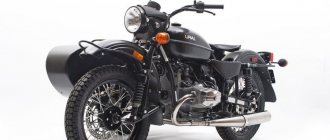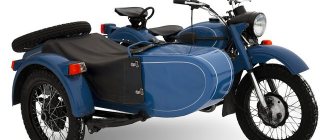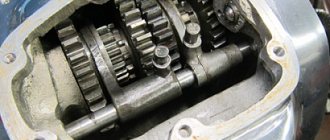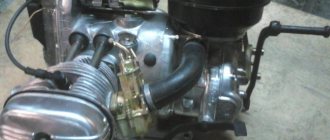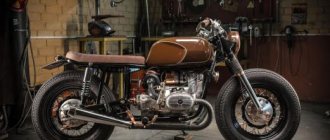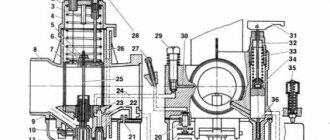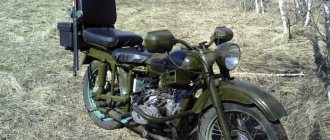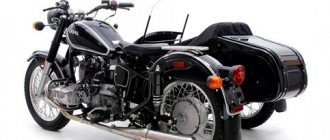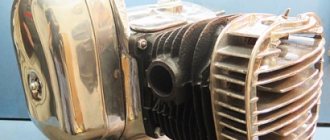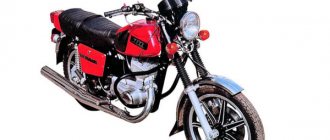Many motorcycle owners take up the task of remaking their iron horses, trying to give them individuality. At the same time, the final result obtained due to the changes made is not always satisfactory. A striking example of this is the legendary Ural motorcycle, tuning of which is associated with certain difficulties. Due to the significant prices for components, such an operation will cost more than, for example, tuning an IZH 5 Jupiter.
A little history
The products of the Irbit Motorcycle Plant are well known not only in our country. Various models, whose design originates from the pre-war BMW R71, have retained their parental genes for seventy years. True, the prefix “Ural” appeared in their name a little later. Since 1961, it has been assigned to the following modifications:
- M-62(1961 – 1963).
- M-63 (1963 - 1971) - this was the so-called Ural-2.
- M-66 (1973 – 1975) received the Ural-3 marking.
Next, it was decided to limit ourselves to the name Ural, removing the additional digital index and leaving only the factory designation.
- M-67 (1973 – 1976).
- M-67-36 (1976 – 1983).
- IMZ-8 (this model has been produced since 1985 and has many different versions).
And this is not counting special versions and limited editions. But in the process of tuning a motorcycle, any of the listed modifications have a lot in common. Despite the changes in the name, all models are similar in design and have similar technical characteristics.
Way to success
The correctness of the decisions made was confirmed by the Second World War, during which the models of the Irbit plant were the main transport of the motorcycle troops of the Soviet Union. The country's leadership so highly appreciated their mobility and versatility that after the victory they initiated the release of two special series at once:
- with a cradle equipped with a PKMB machine gun or ATGM - for arming the army;
- IMZ-8.1233 Solo-DPS - for patrolling.
Plus, we separately developed a line for rally, road, and long-distance travel - “Tourist” IMZ-8.103-40.
In the early 60s, the proud name “Ural” appeared - chronologically it was assigned to the following models coming off the assembly line:
Production of the legend continued even after the collapse of the USSR, despite a significant drop in the purchasing power of the population. Bikes were produced with a two-cylinder and four-stroke boxer engine with a volume of 745 cubic meters, developing power up to 40 HP.
In the mid-90s, designers replaced or modernized almost all parts. At the same time, another significant event took place - the 70th anniversary of the Irbit plant - in honor of which the Ural motorcycle with a sidecar was tuned, so to speak, from the manufacturer, and a special series was released - the M70 Sidecar.
Tuning or restoration?
Remaking new equipment is not very justified financially. It is cheaper to purchase a used, or even broken, copy, and first restore it. If you get your hands on a rare Ural motorcycle, restoration and repair of the rarity will bring greater dividends than the most advanced tuning. After all, in this way we restore and bring history itself back to life.
If the model is ordinary, then there will be nothing wrong with turning an ordinary Ural into a tuned one. In any case, the first step will be to restore the Ural motorcycle to working condition.
Motorcycle "Ural"
A Ural motorcycle with a sidecar in good condition is a real find for DIY tuning. It’s ideal to do this in the off-season - you can while away the boring days and start a new season with a completely new motorcycle.
Tuning a Ural motorcycle with a sidecar can be divided into three types:
- Visual: airbrushing, body kits, various accessories and other “beauties”.
- For comfort: tuning the seats and interior of the stroller, adding cigarette lighters and heated seats, more massive protective glass, an awning or even a roof for the passenger.
- Improving technical characteristics: adding additional light, shock absorption to the stroller, optimizing engine performance.
We will not describe the visual tuning of the Ural motorcycle with a sidecar. Here everyone chooses according to their taste, wishes and financial capabilities. But it is important to understand that with the help of good airbrushing or forging, a motorcycle can be made recognizable and bright, but with cheap airbrushing, it can be given a “collective farm look” to this universal heavyweight.
As for additional accessories for comfort, there is a lot that can be done without severely damaging your wallet. Changing the seat and upholstery of the stroller - if you approach it wisely - will not cost very much, but it will make the ride more comfortable for the passenger, and the motorcycle will look original and expensive. Cigarette lighters and USB outputs in the stroller will also not damage the budget, but will be very useful on the road for charging your phone, for additional light or even a container for heating food.
If you are traveling with a passenger, you can install a wider glass on the stroller or even make a removable roof, for example, by making a frame from plexiglass and covering it with a waterproof awning.
Tuning to increase comfort while traveling can also be done on a budget. For example, an additional light for a stroller can be purchased on various accessory websites. It will allow you to see the road much better, and will make the motorcycle more visible on the highway.
You can install a shock absorber on the stroller. This is worth doing even if you ride alone, as the additional shock absorption of the stroller protects both the luggage in the stroller and the entire motorcycle on difficult sections of the road.
As for improving technical characteristics, it’s unlikely to work out on a budget. The Ural motorcycle is a very reliable and serious piece of equipment. Unauthorized interventions in the main components can lead to breakdowns or unpredictable behavior of the motorcycle on the road. Therefore, if you do something, do it only with the help of professionals.
Very often you can see tuning of the Ural luggage system. It’s not surprising, because this motorcycle is one of the most reliable and is ideal for real long-distance riders who value a calm and leisurely ride. According to the gods of the stroller, you can install additional canisters for water or fuel or a spacious trunk for things.
Source
Choosing a case that suits your needs
Having set the goal of tuning a Ural motorcycle with your own hands, it is important to understand that there are modifications that are relatively painless and do not require documentary evidence to register the vehicle and undergo a technical inspection.
And there are changes that, in order not to conflict with the law, must be agreed upon with the manufacturer or other regulatory authorities. Based on this, tuning for a Ural motorcycle should be divided into two categories:
- Painless, after which there will be no additional paper problems.
- Complex, ideally requiring official paper approval.
We will consider each of these categories separately.
Cooling
As engine power increases, the pistons will require additional heat removal. The problem is solved by installing “extra” air intakes. They are made from any sufficiently strong material, even from paint cans. It is important here to secure the intakes well, but not strictly along the axis of the cylinders, but to position them so as not to limit the possibility of replacing spark plugs on occasion.
Painless changes
You should not assume that any painless tuning for a Ural motorcycle will be easy to do. But, as they say, hunting is worse than bondage. For clarity, we will divide possible alterations into external and internal. The external ones are aimed at correcting the veteran’s appearance, while the internal ones will affect his driving performance and technical characteristics.
Appearance correction
Classic shapes, characteristic of all models without changing, go well with an abundance of chrome parts. Since chromium has good anti-corrosion resistance, it is not forbidden to use it even in the most unexpected places. After this processing, many details will look good:
- Front and rear wings.
- Fuel tank.
- Side panels.
- Engine crankcase, cylinders and cylinder heads.
- Frame and suspension elements.
But if there is no opportunity or desire to do chrome plating, high-quality painting of a Ural motorcycle can be an alternative. There will be room to turn around, especially if you have a modification with a stroller.
Good results can be achieved by installing wings of a different style and size, a different fuel tank, roll bars and even optics. Many favorite modifications - installing a high steering wheel and new control handles, altering the seat - without the right approach, they worsen the rider's position, making it less comfortable. Such changes should be made with caution.
Inner harmony
Many owners start tuning the Urals to improve the technical characteristics of the motorcycle. Despite some orthodoxy in the design of the engine and gearbox, there is room for improvement here. The following steps can be taken:
- Installation of crankshaft (crank) support bearings, the quality of which is better than standard ones. It is not recommended to reduce the size of the support necks themselves. After all, this removes the heat-treated layer and reduces the strength of the critical elements.
- Reduced weight of pistons and connecting rods. Excess mass of these parts leads to an increase in the moment of inertia and a decrease in engine power. Even simply by removing the casting flash, you can significantly reduce the weight and increase the effective output of the power unit.
- Alignment and grinding of inlet and outlet channels. Grinding in valves. Such procedures will improve the filling of the cylinders with the combustible mixture.
- Manufacturing a new camshaft with a different cam profile, allowing the valve timing to be changed. This is a complex engine tuning that requires special knowledge.
- Installation of new carburetors. A well-proven measure that allows you to get rid of failure during acceleration, which is characteristic of all IMZ models without exception.
This is due to the fact that the manufacturer equips the equipment with variable-discharge carburetors, which are poorly suited for four-stroke motorcycle engines. You can get rid of this by equipping the motorcycle with suitable constant-vacuum carburetors. Both Mikuni and Keihin have such models. To optimize operation, the flow area of the nozzles will need to be adjusted. Ideally, such modifications are carried out on a special stand. In the absence of one, one has to be content with fitting in road conditions. After such engine modernization, the Ural will accelerate much more confidently. - Replacing standard air filters with others that have similar throughput but less resistance.
- Installation of inertial boost. This will only work if you purchase components from a reputable manufacturer. There are often low-quality or even non-functional components on the market.
- Manufacturing of new gearbox gears. Despite the relative labor intensity, this motorcycle tuning is more than justified. Original gears are often not of high quality and not only make it difficult to change gears, but also make noise during operation.
- Installation of alloy wheels. Such modernization is not always justified. A cast wheel, if it is not spoked, will look ridiculous on a classic.
Whether you make all the upgrades, or just some, in any case, tuning the Ural motorcycle engine will be completely justified.
Cylinders and pistons
One of the most important parts in an engine is the pistons. They take on a huge load from expanding gases and temperature. Low-quality standard pistons do not withstand loads well, often have different weights, and the piston rings cannot provide high compression due to their outdated design, this significantly affects the power, and the massiveness and number of rings make the piston very heavy, which prevents the engine from spinning. It is recommended to install forged pistons with imported rings. A good solution would be to install forged pistons from the Ural Wolf motorcycle; they have a convex surface, which will increase the compression ratio and significantly increase engine power.
As for the cylinders, it is preferable to replace them with aluminum ones with a cast iron liner. The thermal conductivity of aluminum is much higher, and effective heat dissipation is ensured. A significant improvement in cylinders is relining. The standard internal diameter of the cylinder liner is 78 mm, and if the volume of the standard engine of 650 cubic meters does not suit you, by replacing the original cylinder liners with liners from Moskvich 412 with an internal diameter of 82 mm, you can significantly increase the volume and, accordingly, power. Select the pistons accordingly for the new diameter.
To combat overheating, a cooling system in the form of installing an oil cooler and by forcefully spraying oil onto the bottoms of the pistons will be useful. To connect the oil cooler, an additional oil pump is needed, since the standard one is very weak. To pump oil through the radiator, it is advisable to install an oil pump from a Dnepr motorcycle. Drive the second pump through an adapter from the standard Ural pump. In order for the additional pump to fit in the crankcase, an enlarged sump is required, which will also have a positive effect on cooling. By slightly increasing the amount of oil in the system, it will be possible to distribute the thermal load, and the new aluminum pan will remove heat even better.
By connecting to the new oil pump an oil line made of a copper or steel capillary tube, which must first pass into the radiator, then cooled oil from it must flow to the inside of the pistons. To do this, the line from the radiator enters back into the crankcase and bifurcates so that the oil supply is directed to the bottom of the piston from the inside. An oil cooler can be purchased at a Japanese motorcycle dismantling shop, and an automatic transmission radiator of the size you need from any car is also perfect.
Complex modifications
It is not difficult to guess that this category does not include external changes. But the internal ones are quite enough. Carrying out tuning with their own hands, some owners make adjustments to the design of the motorcycle that are prohibited by law.
- Installation of new mufflers. Despite its apparent simplicity, such modernization requires documentary approval. Otherwise, you will not be able to officially pass the technical inspection.
- Frame modification. Having an impact on the strength of the structure, such tuning for the Ural motorcycle requires preliminary calculations, the results of which are confirmed by specialists.
- Making changes to the brake system. In this case, problems during technical inspection will not be limited to. For unauthorized alteration of brakes, the law does not even provide for a fine, but a real sentence. If you are tuning a Ural motorcycle with your own hands and decide to replace the brake drums with more efficient discs, you must coordinate such changes with IMZ representatives, having received documented permission from them.
Tuning a Ural motorcycle that won’t interfere with the classics - why a motorcycle?
Time does not stand still, technology is constantly evolving, new, more modern opportunities for people appear. But, there is a technique that is not subject to temporary changes: the Ural motorcycle. The pride of the Irbit plant is known to all domestic motorcyclists, and Ural tuning is the real pride of Russia.
Tuned Ural motorcycle
Over the past few years, production has become more modernized, most of the work is done by machines, and Ural tuning has improved significantly. Today, the plant is receiving foreign investment and, together with international specialists, domestic craftsmen are working to improve the model range. Motorcycle tuning and modernization comes to the fore in the company. The successful start of the new generation Ural model M70 Sidecar is evidenced by the tuning of this Ural motorcycle made in accordance with all international requirements.
Tuned Ural motorcycle
According to a sociological survey, the most popular motorcycle of the new millennium is the Ural motorcycle. Tuning it can characterize the owner and depends directly on his preferences. At the factory, most models are equipped with a stroller, which is designed to transport passengers. Tuning a Ural with your own hands can be done regardless of whether the vehicle is equipped with a stroller or not. If it is, you can tune the Ural stroller. There are many useful recommendations on this matter on the Internet; just enter in one of the search engines: “Ural tuning video or Ural motorcycle tuning video.”
The main thing is experience
If you are taking on a motorcycle modification for the first time, you should first experiment with some simpler model. For example, perform tuning of Voskhod 3M - an interesting and very popular model at one time, produced in Kovrov. Thus, you will approach work on the Urals already having some experience. This will help you avoid annoying mistakes.
Previous entry Adjusting the ignition on a Ural motorcycle
Next entry Installing one carburetor on a Ural motorcycle
Current state of affairs
Today the release is aimed at the foreign market. More than 95% of models are sold not in Russia, but in the USA and Canada, European countries, and the Asian market is becoming increasingly important over time. In South Korea or Japan, for example, there are still no worthy competitors in the sector of transport with a cradle; this niche is relatively unoccupied; there are perhaps Chinese replicas that have been copying BMW since the 50s, but they do not have the same status at all.
The total sales volume, if we count from the times of the late USSR, has long exceeded 3,000,000 copies, and this figure continues to grow. This makes it clear why you can so often hear the name “Soviet Harley” - people make the analogy based on popularity, and not on fit or appearance.
Engine
All work must begin with it, because it determines what the frame, landing, and suspension will be like. The power unit can be successfully boosted, but the following points must be taken into account:
- Boring should be carried out on a special machine;
- Only a motor in good condition, either new or overhauled, is suitable;
- as a result of the changes, the torque goes into the high-speed zone, which means the bike becomes more oriented towards rally racing than for quiet riding;
- The pistons should be replaced and the octane number improved from 93 to safely increase the compression ratio to 8.5.
Ignition
Following an increase in power and replacement of pistons, it is advisable to replace the spark plugs. Spark plugs A20 DV and A17 DV from Zhiguli are suitable for Ural. Some craftsmen install an additional candle. This increases engine power at high speeds, reduces consumption and can become a replacement for boost. But work will have to be done to develop an independent spark generation system. At the same time, the air filter is changed, which reduces friction losses during intake.
If the engine is old, then it is advisable to replace the carburetor and install an injector. This can be done with your own hands or with some help. Tuning the Ural motorcycle can be done using injection spare parts from the VAZ "Ten"
At the same time a new starter is installed. Starters from the Vikhr outboard motors ST 353, ST 367, ST 369 are suitable for IM3. VAZ motors - from models 9, 10 and 11 - are also successfully built in place of the originals.
On the subject: How to delete music from an iPhone via iTunes: instructions and recommendations
Specifications
Let's do a full analysis of technical data based on one of the first models - Ural M-62.
Ural M-62
The heavy Soviet motorcycle was equipped with a four-stroke carburetor two-cylinder engine with opposed cylinders and air cooling:
- working volume – 649 cubic meters. cm;
- cylinder diameter – 78 mm;
- piston stroke – 78 mm;
- compression ratio – 6.2;
- maximum power – 28 hp. s., 20.6 kW;
- crankshaft rotation speed at maximum power – 5,000-5,200 rpm;
- maximum torque – 47 Nm;
- carburetor - K-38;
- air cleaner – combined inertial contact-oil filter with two-stage cleaning.
Transmission:
- clutch: dry double-disc, driven discs with linings on both sides;
- cardan transmission: cardan shaft with an elastic coupling and a hinge on needle bearings;
- main gear: a pair of bevel wheels with spiral teeth, gear ratio - 4.62;
- gearbox: four-speed, with gear ratios in 1st, 2nd, 3rd, 4th gears 3.6, 2.28, 1.7, 1.3, respectively.
Electrical equipment:
- ignition system - battery;
- voltage – 6 V;
- battery – ZMT-12;
- generator – G-414;
- relay-regulator – PP-31;
- breaker-distributor – PM05;
- ignition coil - B201.
Chassis:
- frame – tubular double closed type;
- Front wheel suspension – telescopic fork with double-acting hydraulic shock absorbers;
- rear wheel suspension – spring;
- front wheel travel – 80 mm;
- rear wheel travel – 60 mm;
- tire size - 3.75-19 inches;
- brakes are shoe brakes, with friction linings on the front and rear wheels.
Refueling volumes:
- fuel tank – 22 l;
- engine crankcase – 2 l;
- gearbox housing – 0.8 l;
- final drive housing – 0.15 l;
- air purifier – 0.2 l.
Dimensions:
- length – 2,420 mm;
- width – 1,650 mm;
- height – 1,100 mm;
- motorcycle base – 1,100 mm;
- ground clearance at full load and normal tire pressure – 125 mm;
- track – 1,130 mm;
- maximum speed – 95 km/h;
- weight – 340 kg;
- maximum load – 255 kg;
- average operating fuel consumption per 100 km when driving in various road conditions with variable load is 6 liters.
Bright, stylish, but still Dnepr
Looking at this motorcycle, different emotions immediately appear in me. On the one hand, the author of the project had a hand and spent a lot of time creating this “horse”, but on the other hand, I don’t see much point in them. It is unlikely that this homemade seat will be more comfortable than the standard one.
Exhaust
- the highlight of the whole design. As for me, the “cans” are too massive for the pipes that go directly to the cylinders. I think if they were made thicker in cross-section, this modification would look somewhat more impressive.
The colors here are extremely bright and dull
, but this is
a matter of taste
.
And, according to the classics of the genre, we are witnessing the abandonment of the steering wheel and the fact that the author of the project gave preference to clip-ons, completely cutting down the ability to move around on this motorcycle.
Exterior
According to the performance characteristics of the Ural-4320, it is equipped with a metal platform body and a tailgate. The car is equipped with benches, an awning and removable arches. There are also additional lattice sides. The standard equipment includes a three-seat cabin, assembled from thick-walled sheet metal, manufactured by stamping. Thoughtful glazing and rear-view mirrors make it possible to fully monitor the situation on the road and increase visibility.
Structurally, the body is made in the form of short overhangs, which improves cross-country ability. The curb weight of the truck is 8.2 tons. The weight of the transported cargo is up to 67.8 tons with the ability to tow 11 tons.
Description
The Ural motorcycle engine is a two-cylinder, four-stroke, air-cooled power unit. It is equipped with an electronic fuel injection system (injector) developed by the engineering company ElectroJet Inc.
The main power element of the motor housing is the crankcase. Structurally, it consists of:
- the crankcase itself;
- distribution box covers;
- front and rear bearing housings;
- pallet;
- front cover.
The crankcase is cast from high-strength aluminum alloy. Pistons and the junction box cover are also made from it. The cylinders that are installed in the crankcase are cast from special cast iron, which has increased strength. Their internal surfaces are honed before installation, bringing the surface cleanliness to almost a “mirror state”. The materials from which the pistons and cylinders are made during operation form a good anti-friction pair that is not subject to severe wear.
In addition to the parts of the cylinder-piston group, a crank mechanism, a gas distribution mechanism, etc. are installed inside the crankcase and on its outer walls. In this case:
- the camshaft is installed in the upper part of the crankcase on bearing supports, and the pushers are located on its two sides;
- the junction box cover is attached to the front wall;
- the oil filler neck with a plug equipped with a dipstick is located on the left wall;
- the crankshaft is mounted on main bearings installed in the walls;
- From below, the crankcase is closed with a special steel pan, which is used as a reservoir with engine oil.
The assembled engine is installed on the motorcycle frame and secured to it with two studs.
